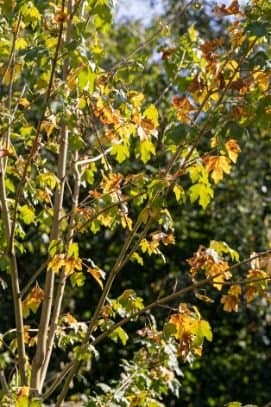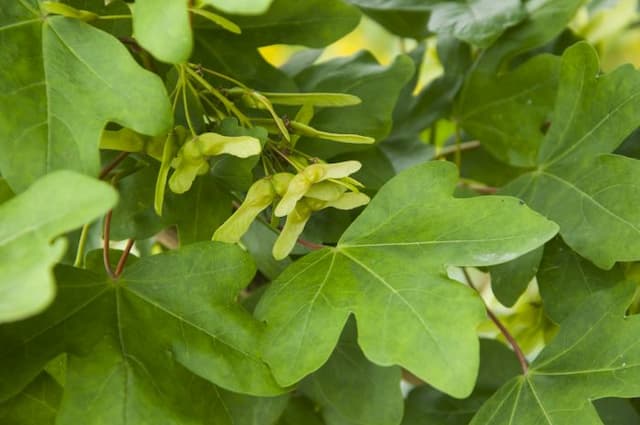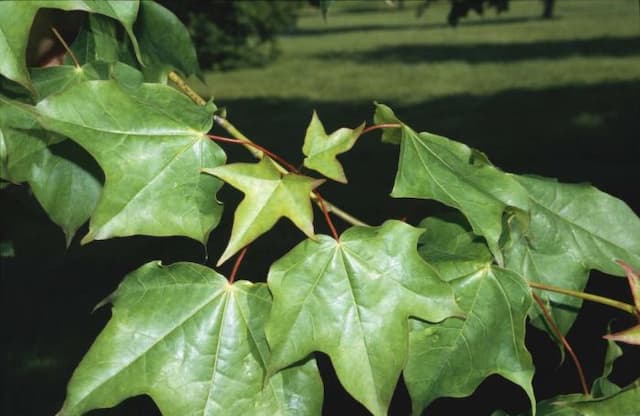Lion's Head Japanese Maple Acer palmatum 'Shishi-gashira' (P)

ABOUT
The Japanese Maple 'Shishi-gashira', also known as the Lion's Head Japanese Maple, is a captivating plant revered for its distinctive aesthetics. The plant is characterized by its crinkled and contorted leaves, which are a deep green color throughout the spring and summer months. This unique foliage takes on the appearance of a tightly curled mane, resembling that of a lion. As the seasons transition into fall, the leaves undergo a dramatic change, showcasing a brilliant display of colors ranging from gold to crimson. The transition imbues the plant with a fiery appearance that is truly a sight to behold. Japanese Maple 'Shishi-gashira' also features an attractive branching structure that adds to its ornamental value. The branches tend to grow in a compact, upright manner, contributing to the plant's overall form and poise. This branching can create a dense canopy, which lends the foliage a tufted and layered look, further enhancing the impression of depth and volume. The overall texture of the Japanese Maple 'Shishi-gashira' is quite tactile, with the deep groves and ridges of the leaves inviting one to reach out and experience the plant through touch. This tactile quality, combined with the visual aesthetics of its leaves and branches, makes the Lion's Head Japanese Maple a prized specimen in gardens for their beauty and sculptural presence.
About this plant
 Names
NamesFamily
Sapindaceae
Synonyms
Lion's Head Japanese Maple, Shishi-gashira Japanese Maple
Common names
Acer palmatum 'Shishigashira'.
 Toxicity
ToxicityTo humans
The Japanese Maple is not known to be toxic to humans. Therefore, ingestion of any part of the Japanese Maple typically does not result in poisoning or produce harmful effects.
To pets
The Japanese Maple is generally considered non-toxic to pets. Ingesting parts of the plant should not cause poisoning or serious consequences in pets such as dogs and cats. However, it is always prudent to monitor for any unusual symptoms and consult a veterinarian if concerns arise.
 Characteristics
CharacteristicsLife cycle
Perennials
Foliage type
Deciduous
Color of leaves
Mixed
Height
15 feet (4.6 meters)
Spread
15 feet (4.6 meters)
Plant type
Shrub
Hardiness zones
5
Native area
Japan
Benefits
 General Benefits
General Benefits- Ornamental Appeal: P, commonly known as Lion's Head Japanese Maple, has a unique shape with dense, crinkled foliage that turns striking shades of red in the fall.
- Compact Size: It is a small tree or large shrub, making it suitable for gardens with limited space.
- Shade Tolerance: This Japanese Maple variety can thrive in partial shade, offering flexibility in garden placement.
- Drought Resistance: Once established, P has a degree of drought tolerance, requiring less maintenance in terms of watering.
- Seasonal Interest: With changing leaves throughout the seasons, it provides year-round interest in the landscape.
- Slow Growth: Its slow growth rate makes it easier to maintain and less likely to outgrow its designated space quickly.
- Attracts Wildlife: The tree can attract birds and other wildlife, providing a habitat and natural beauty to the garden.
- Cold Hardiness: It is relatively cold-hardy, capable of withstanding temperature drops typical of temperate climates.
 Medical Properties
Medical PropertiesThis plant is not used for medical purposes.
 Air-purifying Qualities
Air-purifying QualitiesThis plant is not specifically known for air purifying qualities.
 Other Uses
Other Uses- Crafting Bonsai: Acer palmatum 'Shishi-gashira', commonly known as the Lion's Head Japanese Maple, can be trained to become a unique and striking bonsai specimen.
- Topiary Art: The Lion's Head Japanese Maple is suited for topiary, where it can be sculpted into various formal shapes and styles due to its dense foliage and branch structure.
- Photography: The distinctive shape and beautiful foliage of the Lion's Head Japanese Maple provide an excellent opportunity for photographers, especially during the fall season when the leaves change color.
- Feng Shui: In Feng Shui, the Lion's Head Japanese Maple is believed to bring positive energy to a garden space, representing balance and harmony.
- Theme Gardens: This plant can be a focal point in Japanese-themed gardens or any space requiring a plant with a unique structure and seasonal interest.
- Artistic Inspiration: Many artists use the Lion's Head Japanese Maple as inspiration due to its unique form and vibrant foliage, providing a subject for paintings and drawings.
- Collectible Cultivars: Enthusiasts enjoy collecting different varieties of Japanese Maples, and the Lion's Head Japanese Maple is often a prized addition to such collections due to its rarity and distinctive look.
- Culinary Display: Although not edible, the Lion's Head Japanese Maple can be used to add aesthetic value to outdoor dining areas and restaurant patios.
- Educational Tool: This plant is often used in schools and educational workshops to teach about plant cultivation, particularly pruning and growth habits.
- Film and Theater: Due to its dramatic appearance, it can be used in set design for film and stage productions to create a particular atmosphere or sense of place.
Interesting Facts
 Feng Shui
Feng ShuiThe Japanese Maple is not used in Feng Shui practice.
 Zodiac Sign Compitability
Zodiac Sign CompitabilityThe Japanese Maple is not used in astrology practice.
 Plant Symbolism
Plant Symbolism- Transformation and Change: The Japanese Maple is a symbol of transformation due to its ability to dramatically change color with the seasons.
- Peace and Tranquility: Its elegant form and gracefully shaped leaves often represent peace and calm, making it a common choice for contemplative garden spaces.
- Balance and Practicality: With its sturdy trunk and balanced branch structure, the Japanese Maple signifies the importance of a balanced approach to life.
- Grace and Elegance: The delicate leaves and refined shape of the Japanese Maple represent beauty and refinement.
- Endurance and Patience: Because it can thrive in a variety of climates and conditions, Japanese Maple is also emblematic of strength and the ability to endure life’s challenges.
 Water
WaterThe Japanese maple or 'Shishi-gashira' prefers consistent moisture, so you should water this plant when the top inch of soil becomes dry to the touch. This might translate to watering approximately once a week, but you must adjust based on weather conditions; more frequent watering during hot, dry spells. Use enough water to saturate the root zone, which might be around 2 gallons for a young tree, but mature trees may require 10 gallons or more. Always avoid overhead watering to minimize leaf scorch and fungal diseases. Deep, less frequent watering helps to establish a strong root system.
 Light
LightThe 'Shishi-gashira' Japanese maple thrives in partial shade to full sun, but protection from harsh afternoon sun is beneficial, especially in hotter climates. A spot that receives morning sunlight and dappled afternoon shade is ideal to protect the leaves from burning and to maintain the vibrant foliage colors.
 Temperature
TemperatureThe 'Shishi-gashira' Japanese maple is hardy and can tolerate a range of temperatures, but it performs best in areas where the average temperatures are between 60°F and 80°F. It can generally survive in temperatures as low as -20°F, and it's important to prevent it from prolonged exposure to temperatures over 90°F which can cause leaf scorch.
 Pruning
PruningPruning the 'Shishi-gashira' Japanese maple should be done to remove any dead or damaged branches, to shape the tree, and to improve air circulation within the canopy. The best time to prune is in late winter or early spring before new growth begins, as this helps prevent bleeding of sap. Regular pruning is not necessary every year, rather it should be performed as needed.
 Cleaning
CleaningAs needed
 Soil
SoilThe best soil mix for 'Shishi-gashira', or Lion's Head Japanese Maple, should be well-draining, with a mix of loam, peat, and sand. It prefers a slightly acidic pH around 5.5 to 6.5.
 Repotting
RepottingRepot the Lion's Head Japanese Maple roughly every two to three years to prevent root-bound conditions and refresh the soil.
 Humidity & Misting
Humidity & MistingLion's Head Japanese Maple prefers moderate humidity but is adaptable to the average outdoor humidity levels it encounters in its hardiness zones.
 Suitable locations
Suitable locationsIndoor
Ensure bright light, protect from drafts, and water sparingly for indoor Lion's Head Japanese Maple.
Outdoor
Plant in partial shade, provide mulch, and shelter from strong winds for outdoor Lion's Head Japanese Maple.
Hardiness zone
5-9 USDA.
 Life cycle
Life cycle'Shishi-gashira', commonly known as the lion's head maple, begins its life as a seed which, under favorable conditions, will germinate in spring after stratification through cold winter months. The seedling emerges and gradually develops into a young sapling, characterized by its unique crinkled and tufted leaves. Over several years, this sapling matures into an adult tree, which exhibits a slow to moderate growth rate and reaches up to 10-15 feet tall. The lion's head maple reaches its reproductive maturity within a few years, producing small red flowers that turn into samaras, the winged fruit typical of maples. After fertilization, these samaras disperse by wind, allowing for the potential establishment of new seedlings. Throughout its life, which can span several decades, 'Shishi-gashira' experiences an annual cycle of dormancy in winter and a flush of growth each spring, with autumn showcasing its vibrant crimson foliage before leaf drop.
 Propogation
PropogationPropogation time
Late winter
The recommended time to propagate the Japanese Maple 'Shishi-gashira' is during its dormant period, which typically occurs in late winter to early spring before new growth begins. The most popular method of propagation for this variety of Japanese Maple is through softwood cuttings. To propagate this plant using cuttings, take a cutting of about 4 to 6 inches (10 to 15 centimeters) long from a healthy, young branch. Remove the leaves on the lower half of the cutting and dip the cut end into rooting hormone powder to encourage root growth. The treated cutting is then inserted into a pot filled with a well-draining soil mixture. The cutting should be kept moist and in a warm environment with indirect light until roots have developed, which can take a few weeks to a few months. Once the roots are established, the new plant can be transplanted into its permanent location.







![Freeman maple [Autumn Blaze]](/_next/image?url=https%3A%2F%2Fplants-admin.emdemapps.com%2Fimages%2Fplants%2F%2Fimages%2F604b575b84d87.png&w=640&q=75)

